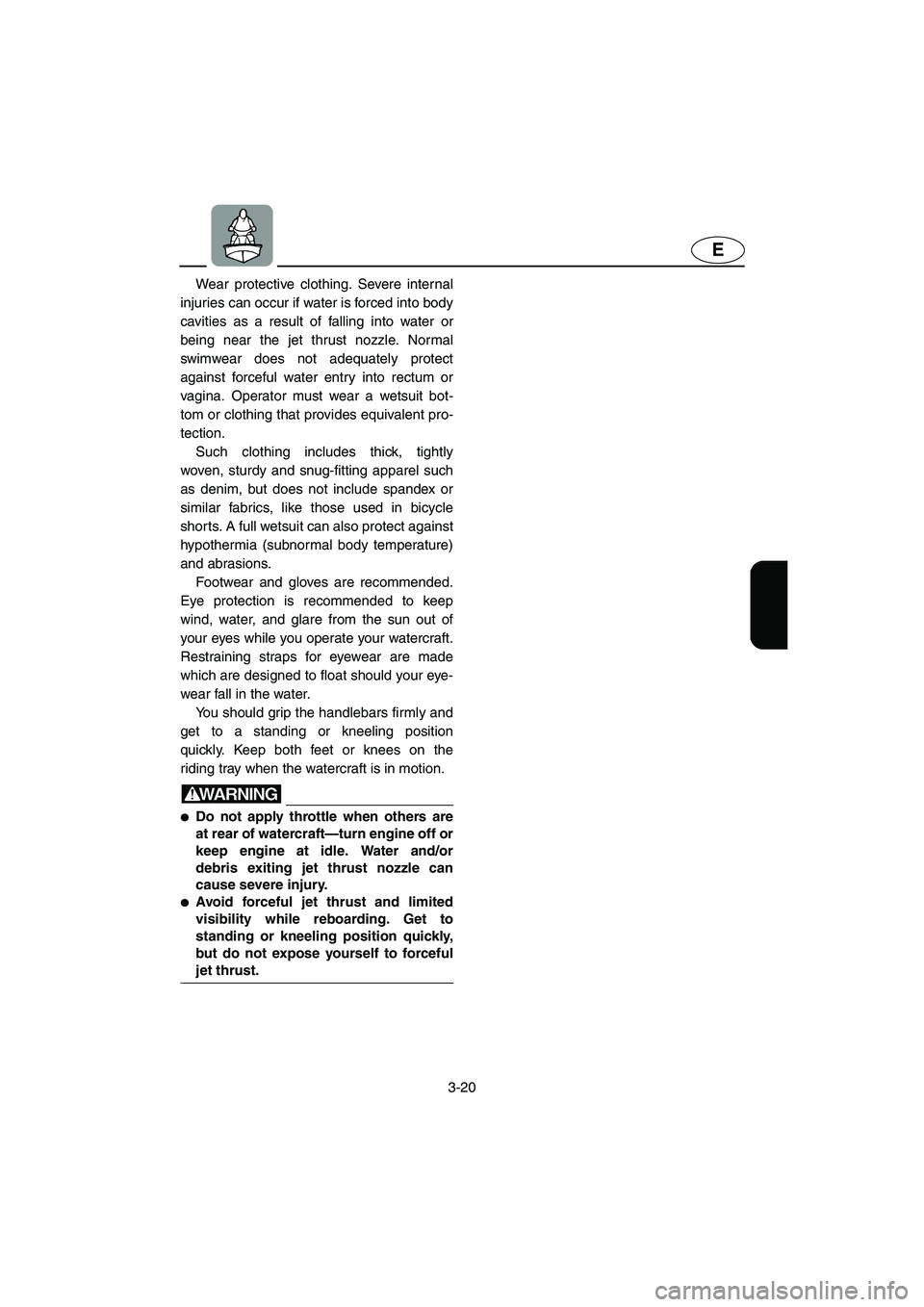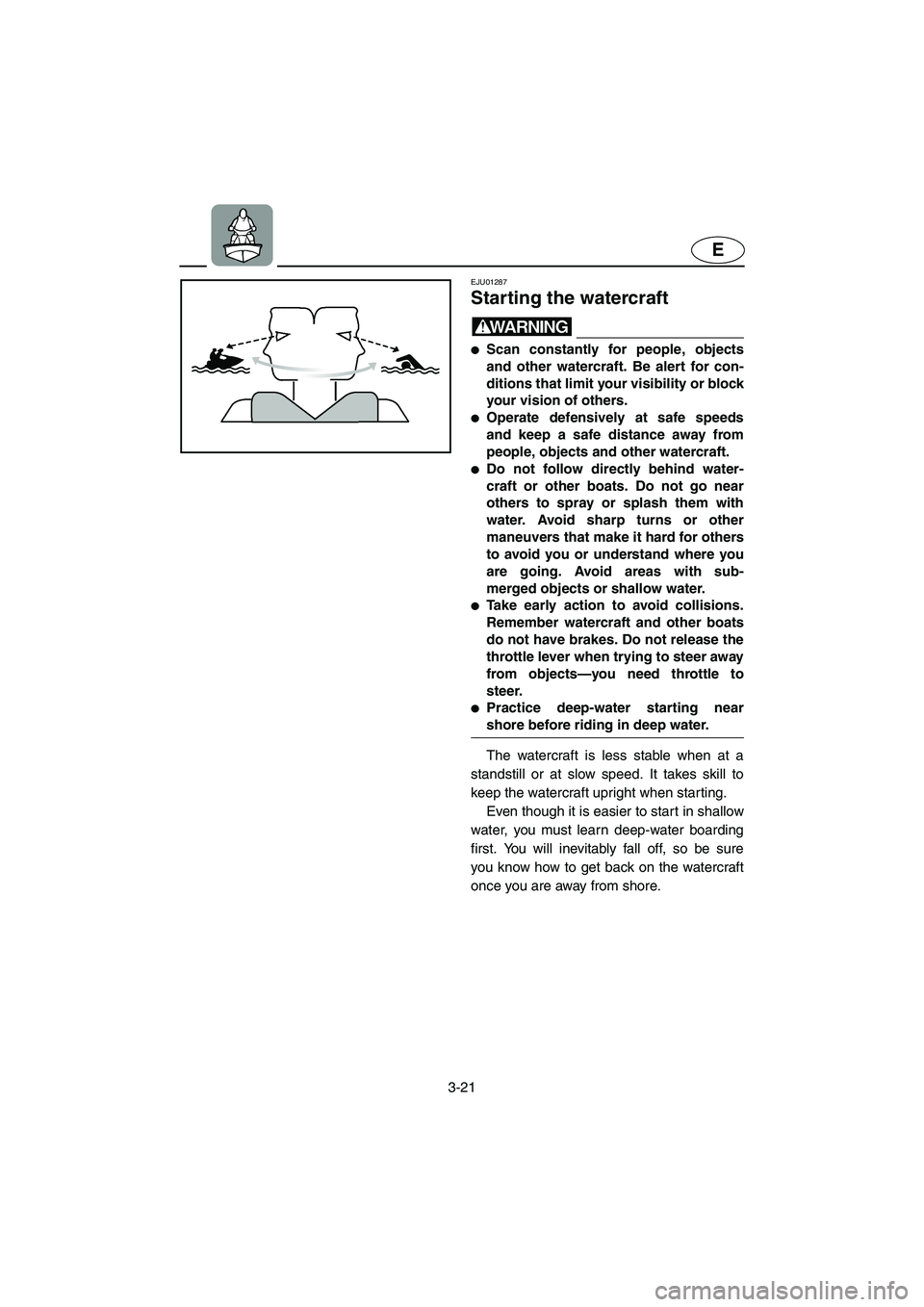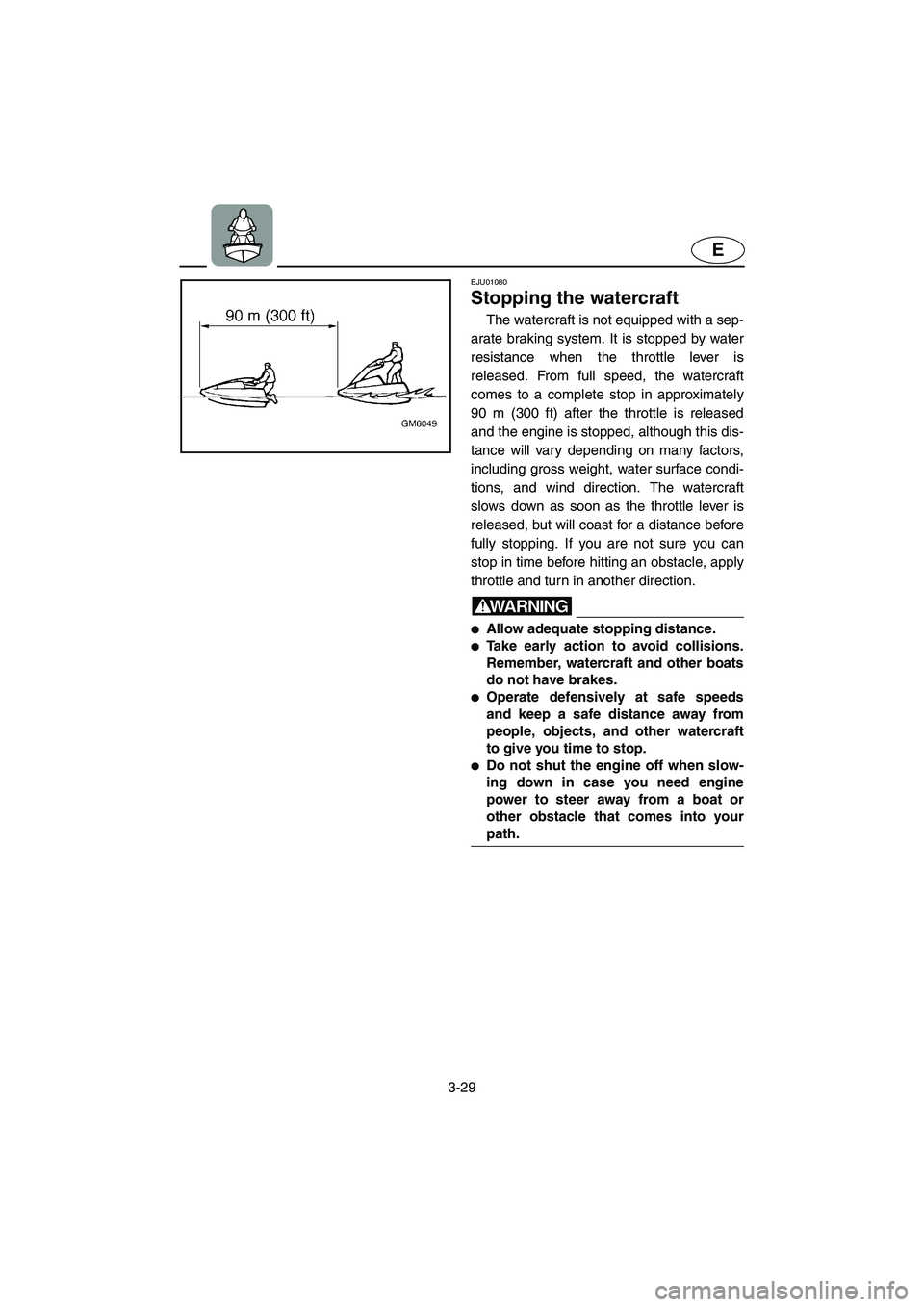Page 51 of 104
3-18
E
EJU01066
Stopping the engine
To stop the engine, release the throttle
lever, and then push the engine stop switch
(red button).
WARNING@ You need throttle to steer. Shutting off
the engine can cause you to hit an obsta-
cle you are attempting to avoid. A colli-
sion could result in severe injury or
death.
@
EJU01067
Leaving the watercraft
If leaving the watercraft, remove the
engine shut-off cord to reduce the chance of
accidental starting or unauthorized use by
children or others.
UF1N71.book Page 18 Tuesday, June 4, 2002 3:34 PM
Page 52 of 104

3-19
E
EJU01068
Operating your watercraft
EJU01285
Getting to know your
watercraft
Operating your watercraft requires skills
acquired through practice over a period of
time. Take the time to learn the basic tech-
niques well before attempting more difficult
maneuvers.
Operating your new watercraft can be a
very enjoyable activity, providing you with
hours of pleasure. However, it is essential to
familiarize yourself with the operation of the
watercraft to achieve the skill necessary to
enjoy riding safely. Before operating this
watercraft, read this Owner’s/Operator’s
Manual, the Riding Practice Guide, and all
warning and caution labels on the water-
craft. Pay particular attention to the safety
information on pages 1-6 to 1-12. These
materials should give you an understanding
of the watercraft and its operation.
Remember: This watercraft is designed to
carry the operator only. Never have more
than one person on the watercraft at any
time.
EJU01286
Learning to operate your
watercraft
Before operating, always perform the
pre-operation checks listed on page 3-5.
The short time spent checking the watercraft
will reward you with added safety and reli-
ability.
Check all local laws before operating your
watercraft.
Operate defensively at safe speeds and
keep a safe distance away from people,
objects and other watercraft. Select a wide
area to learn in, where you have good visi-
bility and light boat traffic.
Use the buddy system—operate with
someone nearby. Scan constantly for peo-
ple, objects and other watercraft. Be alert for
conditions that limit your visibility or block
your vision of others.
Attach the engine shut-off cord (lanyard)
to your wrist and keep it free from the han-
dlebars so that the engine stops if the opera-
tor falls off.
Wear a personal flotation device (PFD).
All riders must wear a PFD that is approved
by the appropriate authorities and suitable
for personal watercraft use.
UF1N71.book Page 19 Tuesday, June 4, 2002 3:34 PM
Page 53 of 104

3-20
E
Wear protective clothing. Severe internal
injuries can occur if water is forced into body
cavities as a result of falling into water or
being near the jet thrust nozzle. Normal
swimwear does not adequately protect
against forceful water entry into rectum or
vagina. Operator must wear a wetsuit bot-
tom or clothing that provides equivalent pro-
tection.
Such clothing includes thick, tightly
woven, sturdy and snug-fitting apparel such
as denim, but does not include spandex or
similar fabrics, like those used in bicycle
shorts. A full wetsuit can also protect against
hypothermia (subnormal body temperature)
and abrasions.
Footwear and gloves are recommended.
Eye protection is recommended to keep
wind, water, and glare from the sun out of
your eyes while you operate your watercraft.
Restraining straps for eyewear are made
which are designed to float should your eye-
wear fall in the water.
You should grip the handlebars firmly and
get to a standing or kneeling position
quickly. Keep both feet or knees on the
riding tray when the watercraft is in motion.
WARNING@ �Do not apply throttle when others are
at rear of watercraft—turn engine off or
keep engine at idle. Water and/or
debris exiting jet thrust nozzle can
cause severe injury.
�Avoid forceful jet thrust and limited
visibility while reboarding. Get to
standing or kneeling position quickly,
but do not expose yourself to forceful
jet thrust.
@
UF1N71.book Page 20 Tuesday, June 4, 2002 3:34 PM
Page 54 of 104

3-21
E
EJU01287
Starting the watercraft
WARNING@ �Scan constantly for people, objects
and other watercraft. Be alert for con-
ditions that limit your visibility or block
your vision of others.
�Operate defensively at safe speeds
and keep a safe distance away from
people, objects and other watercraft.
�Do not follow directly behind water-
craft or other boats. Do not go near
others to spray or splash them with
water. Avoid sharp turns or other
maneuvers that make it hard for others
to avoid you or understand where you
are going. Avoid areas with sub-
merged objects or shallow water.
�Take early action to avoid collisions.
Remember watercraft and other boats
do not have brakes. Do not release the
throttle lever when trying to steer away
from objects—you need throttle to
steer.
�Practice deep-water starting near
shore before riding in deep water.
@
The watercraft is less stable when at a
standstill or at slow speed. It takes skill to
keep the watercraft upright when starting.
Even though it is easier to start in shallow
water, you must learn deep-water boarding
first. You will inevitably fall off, so be sure
you know how to get back on the watercraft
once you are away from shore.
UF1N71.book Page 21 Tuesday, June 4, 2002 3:34 PM
Page 55 of 104
3-22
E
EJU01378
Boarding and starting in deep
water
1. Swim to the rear of the watercraft. Attach
the engine shut-off cord to your wrist.
Attach the clip to the engine shut-off
switch.
2. Grasp the handlebars with both hands.
Pull your body up onto the riding tray and
balance there, using your elbows on the
gunwales for leverage.
3. Start the engine and begin to accelerate.
4. Continue to pull your body up onto the
watercraft as the watercraft speed
increases.
5. Bring your knees up onto the riding tray
and change to a kneeling position as
soon as you can do so.
WARNING@ Avoid forceful jet thrust and limited visi-
bility while reboarding. Get to standing
or kneeling position quickly, but do not
expose yourself to forceful jet thrust.
@
UF1N71.book Page 22 Tuesday, June 4, 2002 3:34 PM
Page 61 of 104
3-28
E
To maintain your balance, lean into a turn.
How much you lean depends on the tight-
ness of the turn and your traveling speed. In
general, the higher the speed or the sharper
the turn, the more you lean.
WARNING@ Do not release the throttle when trying to
steer away from objects—you need throt-
tle to steer. A collision could result in
severe injury or death.
@
UF1N71.book Page 28 Tuesday, June 4, 2002 3:34 PM
Page 62 of 104

3-29
E
EJU01080
Stopping the watercraft
The watercraft is not equipped with a sep-
arate braking system. It is stopped by water
resistance when the throttle lever is
released. From full speed, the watercraft
comes to a complete stop in approximately
90 m (300 ft) after the throttle is released
and the engine is stopped, although this dis-
tance will vary depending on many factors,
including gross weight, water surface condi-
tions, and wind direction. The watercraft
slows down as soon as the throttle lever is
released, but will coast for a distance before
fully stopping. If you are not sure you can
stop in time before hitting an obstacle, apply
throttle and turn in another direction.
WARNING@ �Allow adequate stopping distance.
�Take early action to avoid collisions.
Remember, watercraft and other boats
do not have brakes.
�Operate defensively at safe speeds
and keep a safe distance away from
people, objects, and other watercraft
to give you time to stop.
�Do not shut the engine off when slow-
ing down in case you need engine
power to steer away from a boat or
other obstacle that comes into your
path.
@
UF1N71.book Page 29 Tuesday, June 4, 2002 3:34 PM
Page 66 of 104
3-33
E
EJU01956
Transporting
WARNING@ Always place the fuel cock knob in the
“OFF” position when transporting the
watercraft, otherwise fuel could leak out
into the engine or engine compartment,
which would create a fire hazard.
@
Transport this watercraft using the special
trailer that incorporates a hole into which the
pin 1 can be inserted and locked after
passing it through the rope hole 2.
After securing the bow with the pin,
secure the stern with ropes or tie downs 4
over the gunwale. Use a rubber shock
cord3 to hold the steering pole.
CAUTION:@ �Do not route ropes or tie downs over
the steering pole, as they may damage
it. Also, wrap the ropes or tie downs
with towels or rags where they touch
the body of the watercraft to avoid
scratching or damage.
�Do not transport the watercraft with
steering pole up, or the steering pole
may be damaged during transporta-
tion.
@
UF1N71.book Page 33 Tuesday, June 4, 2002 3:34 PM